“I was seldom able to see an opportunity until it had ceased to be one.â€
Mark Twain
The wealth of natural, cultural and historic capital on Johns Island provides numerous opportunities to improve the quality of life for those who live and visit here.
Natural Landscape: Forest, Marsh, Water and Wildlife.
Open, natural landscapes are important for maintaining wildlife habitat and the health of our ecosystem. They also provide recreational opportunities for our people.
Conservation Easements
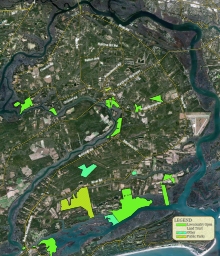
Conservation Easements on Johns Island (click to enlarge)
Conservation easements are one of the best tools we have for preserving green space and limiting over-development. The Lowcountry Open Land Trust (LOLT) has preserved many properties on Johns Island, including the recent protection of 35 acres surrounding the Angel Oak.
Can innovative conservation easements be created that protect working farms and smaller properties? Can easements be used to protect open spaces in property and neighborhood associations to prevent a simple majority of property owners from disposing of common areas? Can controlled public access be incorporated in some private conservation easements?
Government Support
Conservation easements are often made possible through the use of the County Greenbelt Bank, which is funded by the county sales tax. Other government agencies also play a critical role in maintaining our natural landscape. ![]() These agencies are both an opportunity and a resource for accomplishing conservation goals.
These agencies are both an opportunity and a resource for accomplishing conservation goals.
How can the public support these agencies during times of tight budgets? Can nonprofit groups work more closely with these agencies to meet common goals? Can technology be used better to meet the educational and enforcement responsibilities of these agencies?
Recreation
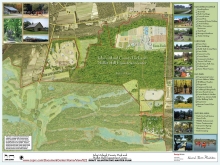
Mullet Hall County Park long-range plan (click to enlarge)
Our natural landscapes support a wide range of recreational pursuits, including hunting, fishing, bird watching, boating, kayaking, photography and hiking to name just a few. Today, many of these activities are branded as “ecotourism†and are an important economic opportunity for Johns Island.
The County and City parks departments play an important role in public access to our natural landscape and recreational opportunities. Mullet Hall County Park already offers an excellent equestrian facility. There are plans to expand the park but, as with so many public projects these days, funding may be a problem.
Can Mullet Hall Park be expanded sooner instead of later, especially for recreational access to the Kiawah River and marsh? If funding is needed, can a public-private partnership make this happen? Can the many utility easements throughout the center of the Island be used to create recreational pathways (hiking, biking, equestrian)?
Cultural Landscape: People, Heritage and History
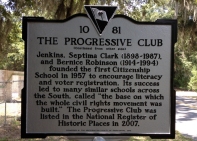
Click to enlarge
Johns Islanders are a distinct people from a once-remote place that was uniquely shaped by history, community and self-reliance. But unless we share that story with others – particularly newcomers and young people – our cultural heritage could be lost.
Current generations have grown up with little connection to the realities that shaped their grandparents’ lives, and every year more of that living history disappears. As H. G. Wells said, “History is a race between education and catastrophe.†Recording and communicating our history can help us preserve what is good about Johns Island and avoid the catastrophe of over-development.
The Gullah Tradition
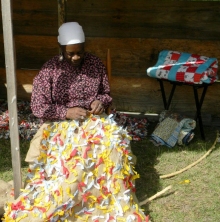
(click to enlarge)
Sharon Cooper-Murray is the Gullah lady. Her mission is to increase awareness of the Gullah culture and facilitate understanding of their way of life; language, music, arts and crafts. She specializes in creating Gullah rag quilts and frequently runs workshops at the Charleston Museum. Visit her at her website or on her Facebook page
Like the rest of the South, Johns Island’s culture and history are twin stories. From the rise of an antebellum economy built on slavery, to the separate-but-not-equal time of Jim Crow, to the Civil Rights era, black and white culture here is intertwined in complex ways.
Yet this adversity and isolation created and sustained a unique community we now recognize as the Gullah culture. Gullah’s living legacy has bequeathed us interesting and useful crafts, such as quilt making and sweet grass baskets. We also reap the blessings of its music, its language and its influence on Lowcountry cuisine.
The most valuable gifts we may inherit from Johns Island’s native Gullah culture could their lessons of self-sufficiency and sustainability. With marginally more autonomy than enslaved Africans in other areas of the South, black residents of the Sea Islands produced a culture that sustained itself and thrived even under the harsh limits forced upon it. If the modern world truly wants to get back to these values, we should take some lessons from those who never abandoned them.
Can we do more to protect our Gullah heritage? What could be done to link those efforts to the international interest in Gullah culture? What federal support might we find for those efforts? Is there a place on Johns Island for a new interpretation of the traditional “folk school,” with the usual emphasis on teaching crafts, trades, arts and culture — but with a Gullah twist? Could such a school support the other opportunities outlined here?
The Gullah Geechee Cultural Heritage Corridor is a National Heritage Area administered by the National Park Service in partnership with State Historic Preservation Offices. This program may provide some of the answers to these questions.
Civil Rights
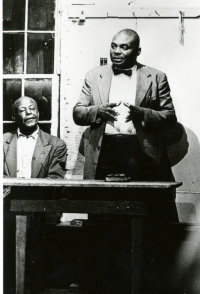
Esau Jenkins speaking at the Progressive Club (click to enlarge)
As part of a strong and cohesive community based on Gullah traditions, African Americans on Johns Island were well-positioned to play an important role in the Civil Rights movement of the mid twentieth century.
Esau Jenkins, who helped found the Progressive Club here, was a Johns Island native. Septima Clark taught here for many years. During the 1960s, civil rights leaders from Martin Luther King Jr. to Stokely Carmichael visited the Progressive Club to meet with local leaders and encourage their efforts. Island native Bill Saunders, who remains active locally, is a living link to that era.
The advances of the civil rights movement — or as Saunders likes to call it, the human rights movement — also freed whites to look past their own history and look forward to developing better relations.
Can efforts to conserve Johns Island’s character be incorporated into the continuing work to improve race relations ?
A Battleground
Johns Island saw significant action during both the Revolutionary War and the Civil War.

Civil War reenactment at Legare Farms (click to enlarge)
The Revolution divided neighbors. The Gibb family were prominent patriots, while Thomas Fenwick of Headquarters Plantation joined British troops to attack a local militia encampment on the Stono River. In 1780, roughly 10,000 British soldiers landed on Seabrook and marched across Johns Island to participate in the siege of Charleston.
During the Civil War there were two naval actions in the Stono River and two battles on Johns Island. The antebellum “resort†village of Legareville was also destroyed at the end of the war.
Lesser known is the origin of our executive airport, which began as an Army Air Corps emergency landing airfield in World War II. It is said to have been constructed by German POWs. All these conflicts had a significant impact on Johns Island’s people and its economy.
Historic Sites
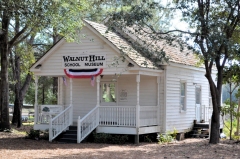
Click to enlarge
Because of Johns Island’s rural history, few historic structures have survived. Not only should those that remain be treasured and preserved, they can also serve as focal points for many of the opportunities discussed in this section.
The old Walnut Hill Schoolhouse, which houses the Johns Island Museum, was built during Reconstruction as a one-room schoolhouse and served that purpose into the 1930s.
Most Johns Island plantations featured relatively modest wood-frame houses, none of which have survived. The only “grand†house on the Island was the Georgian residence at Fenwick Hall, part of the former Headquarters Plantation on the Stono River. The house is privately owned and is on the National Register of Historic Places.
There are other plantation sites on Johns Island where archaeological remains, including slave quarters, are thought to exist. While some have been surveyed, none has been researched in depth.
Churches and Cemeteries
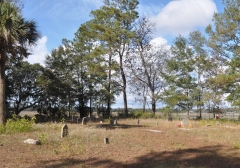
African American cemetery on Bohicket Creek with 19th graves. Still in use today.
Johns Island is home to dozens of houses of worship. If Charleston is the “Holy City,†certainly Johns Island would qualify as the “Holy Island.†These churches are community gathering places as well as houses of worship. There are ![]() four of particular historic significance worthy of special note.
four of particular historic significance worthy of special note.
Historic Churches
- The Johns Island Presbyterian Church was originally built in 1719 and is on the National Register of Historic Places. The current building was extended in 1823 and improvements made during the 20th century including extensive renovation 1995. The graveyard includes internments for many of Johns Island’s oldest family’s whose descendants still live here.
- The St. John’s Parish Church was founded in the early 18th century as one of four original Church of England parishes in the lowcountry: St. James, St. Andrews, St. Johns and St. Pauls. The current church building dates from the 19th Cemtury though the cemetery includes graves from as early as the parish’s establishment.
- The Old Hebron Church on Betsy Kerrison Parkway was built by freed slaves after the Civil War after they ceased to attend the formerly integrated Johns Island Presbyterian Church. The Church was built using driftwood retrieved from the beaches of Kiawah and Seabrook Islands. The Church is owned by the newer Hebron Zion Presbyterian congregation and is undergoing renovation as a community center.
- Enslaved Africans were generally not allowed to attend services in white churches (the Johns Island Presbyterian Church was a notable exception). What worship they were allowed took place in private homes in the slave quarters, one of which often became designated as the “praise houseâ€. After emancipation, with few ministers, freed blacks continued this tradition by establishing praise houses throughout the sea-islands. The members of these congregation participated in the services – preaching, testifying and singing as the spirit moved them. A good part of African-American music- gospel, jazz, R&B – and therefore all modern American music can be traced to the praise houses. The Moving Star Praise Hall on Johns Island is the last remaining structure of its kind listed on the South Carolina National Register.
Most churches also have their own cemeteries, some of which are well documented. In addition there are numerous family and community cemeteries throughout the island that are not as well known. These too are sacred places that need to be identified and preserved.
Research, Scholarship, Education and Learning.
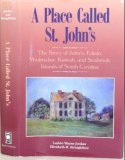 Betty Stringfellow’s book “A Place Called St. John’s†provides a good overview of the Island’s history
Betty Stringfellow’s book “A Place Called St. John’s†provides a good overview of the Island’s history. However there is much more to Johns Island’s rich and varied history that has not been thoroughly researched and documented — especially from the African American perspective. For example, what role did root doctors play as health providers, both physical and mental, and is there anything useful we can learn from them about the medicinal properties of native plants?
Many older people still have memories of stories from their parents and grandparents, but these are being lost as they pass. There are documents and artifacts hidden in attics and buried in the ground. But these are being lost as more islanders move “off†or pass on and developers dig up the ground for new housing.
 The Avery Center for African American studies at the College of Charleston is an excellent resource. They are the repository for Esau Jenkins’ and Septima Clark’s papers. The South Carolina Historical Society in Charleston and the Charleston Library Society also have excellent archives that include many original and secondary sources relevant to Johns Island.
The Avery Center for African American studies at the College of Charleston is an excellent resource. They are the repository for Esau Jenkins’ and Septima Clark’s papers. The South Carolina Historical Society in Charleston and the Charleston Library Society also have excellent archives that include many original and secondary sources relevant to Johns Island.
Can all of these threads of history and culture be brought together in a single museum or cultural center specific to Johns Island? Or could multiple specialized facilities in different locations be tied together? Would these attractions be of interest to visitors and provide some self-sustaining revenue? Could incentives and resources be provided to scholars to encourage them to focus on Johns Island topics for their research?
The Conservancy has been working to have the Johns Island Schoolhouse Museum preserved, possibly as part of such an establishment. The Stringfellow family, which owns the museum, is considering the future options for it.
Working Landscape: Farms, Food and Family
The most important historic site on Johns Island is the land. The fields, farms and marsh were shaped by those who came here and the Island’s culture was in turn formed from the land.
Heritage
Johns Island has a unique multi-season micro-climate and some of the best soil in the country. This farmland is our most important historic site. From farm fields to oyster beds, Johns Island’s land and water provided the basis for a self-sufficient, sustainable, healthy lifestyle.
This way of life is in the midst of a modern revival. Yet even as regional demand for quality, locally grown food rises, land prices and development pressures are driving Johns Island agriculture toward a crisis. It’s a race between the value of land for development and the value that can be produced from the land. Once development takes over, it is virtually impossible to go back.
Johns Island agriculture has survived by adapting to changing markets. “Factory farming†and competitive commodity agribusiness are not options here. Johns Island’s historic success for growing top-quality produce remains the key. The expanding “localvore†movement, the Charleston dining renaissance and the flourishing international interest in Lowcountry cuisine are all emerging trends that could support this future. It doesn’t hurt that the Charleston Convention and Visitors Bureau now lists food alongside history as the area’s No. 1 tourism draw.
Can 21st century Johns Island farmers use the island’s unique advantages to become the Lowcountry’s premium producer for these markets? Can cooperation and innovation — both on the island and with our Lowcountry neighbors — raise Johns Island’s profile as both a source for desirable food and a destination for gourmet travelers in search of authentic tastes and experiences? Can local entrepreneurs and farmers build the sustainable, food-based businesses that will add jobs and grow our economy?
Farm-toTable

Rosebank Farms packing shed where CSA portions are prepared. (click to enlarge)
“Farm-to-table†agriculture includes a number of marketing options that can improve a farmer’s profits. These opportunities place a higher value on quality products, reduce transportation costs and eliminate some of the middle-man expenses. Farm -to-table programs include farm stands, Community Supported Agriculture (CSA), farmer’s markets, direct purchase by restaurants and cooperative stores, which can be either independently owned or farmer-owned. One innovative farm-to-table approach puts a farmer in close collaboration with a chef or retailer who commissions specific products.
Johns Island producers and purveyors including Legare Farms, Rosebank Farms, Stono Market, Black Bird Market, Fields Farms and Homegrown Farmers Market on Maybank Highway have adopted various combinations of these programs.
Many Johns Island farmers are already involved in these efforts. Can they be expanded without diluting the market with over supply? How could we foster a critical mass of food-related businesses (farms, artisan-made products, farm-fresh distribution, traditional and gourmet dining, bed-and-breakfast inns and food-related experiences) that would establish Johns Island as a national destination for gourmet travelers? What local partnerships might move that idea forward?
Cooperation
Cooperation between farmers has a long tradition in the United States, from formal co-op organizations to informal sharing of knowledge and equipment. Large corporate farms do not follow this model and are generally based on competition, not cooperation. Governments and nonprofit organization offer smaller farmers some beneficial programs, but to survive and thrive, independent operators often must work together and pay close attention to their customers.
At the same time, small farmers value their independence and do not like to be told what to do. They can also profit from developing unique methods and products that remain proprietary. They cannot always be expected to give away this knowledge. A key to successful cooperation is developing programs and creating organizations that strike a balance between the need to cooperate and the impulse to go it alone.
Is there a role for a farmer’s co-op on Johns Island? Can we come up with new ideas and incentives — perhaps using inexpensive communications technologies — to expand and improve less-formal types of cooperation?
Incubator Farms
One current example of a cooperative effort on Johns Island is the “Dirt Works Incubator Farm.†Incubator farms provide would-be farmers small amounts of land, shared infrastructure, and access to experienced growers who agree to act as mentors. The Johns Island program is sponsored by Lowcountry Local First and is the lowcountry’s only incubator program. The “Dirt Works†farm is located at the Walnut Hill Plantation and is co-sponsored by the Limehouse Family.
Can incubators help more farmers succeed here? What would make the program more effective? How can we help those farmers take the next step beyond the incubator?
Marketing and Branding

Click to enlarge
After World War II, Johns Island became well known for its “Irish†potatoes. Tomatoes took over in the 1950s, and for decades Johns Island tomatoes were considered among the best in the country. By the end of the 20th century most tomato production had moved to California and south of the border.
With the revival of both these crops in heirloom varieties and the “discovery†of other varieties of “boutique†produce, Johns Island’s natural advantages provide an opportunity for our small farmers to profit from these trends.
But in today’s markets reputation and word-of-mouth, while important, don’t guarantee success. Maximizing the value of Johns Island produce also requires modern branding and marketing programs that include publicity and social media. When trends develop, they must be recognized and taken advantage of quickly – capacity increased and distribution ramped up.
These situations highlight the dilemma between cooperation or propriety success for individual farmers. On a large scale, will a farmer make more profits as their own individual brand or through participation in a comprehensive Johns Island or Sea Island marketing campaign?
Can cooperative marketing and branding provide better opportunities for all Johns Island’s farmers? Can professional efforts expand Johns Island’s reputation and markets beyond just the Lowcountry?
Equestrian
One distinctive aspect of Johns Island’s working landscape is our many horse farms. This is a place with a long equestrian history, from thoroughbred racing at 19th century Fenwick Hall to some still-living Johns Islanders who grew up plowing their fields behind mules. There are significant reasons to believe we could have a successful equestrian future.
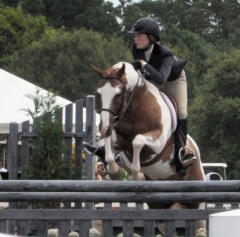
Click to enlarge
Large properties with open space and beautiful scenery are attractive to wealthy horse owners. While this is a limited market, an initiative that targets affluent horse owners could provide economic benefits for the whole island.
In addition, many people of more modest means are committed to an equestrian lifestyle. They choose to live where they can own a few acres and keep a couple of horses, or perhaps board a horse at a nearby commercial stable. Johns Island may have a unique opportunity to become both the high-end equestrian enclave for the lowcountry as well as a place where people enjoy keeping “backyard horses”.
Johns Island is already the home of the Charleston County Parks and Recreation Commission’s Mullet Hall Equestrian Center, one of the finest public facilities of its kind in the Southeast, attracting visitors from across the region. Mullet Hall County Park has a system of trails that covers hundreds of acres. Yet as a riding destination its appeal remains relatively limited as owners must transport their horses to the park and there is no direct access from any commercial stable. Offering a wider variety of places to ride would be a great way to encourage equestrian uses that preserve our working landscape.
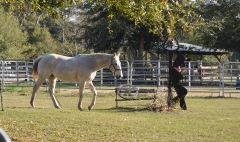
Click to enlarge
A model for better equestrian trails might be found around Tryon, N.C., where an innovative and extensive network of scenic horse trails gives the community a national reputation among horse enthusiasts. What makes that network remarkable is that the trails pass through privately owned property as a result of negotiated easements.
Johns Island already has a network of utility easements and canal paths that could form the basis of such a trail system — if liability issues could be addressed and arrangements made with the property owners. A well-developed trail system would offer an amenity that creates tremendous value for the island’s natural and working landscapes.
Would an “Equestrian Association†help support existing horse owners and businesses? Could an association improve Johns Island’s reputation as an equestrian community and attract additional farms and commercial interests? Is there a commitment on the Island to form an Association?
Economic Landscape
TABLE OF CONTENTS
Development and Alternatives
The value of land and the prospects for economic development on Johns Island are almost always viewed solely in terms of building houses. Little thought is given to the potential value of the land for other uses. Developers like to tout the historic character of Johns Island, “green space,†wildlife, recreational opportunities and the natural environment. On the micro level, for individual projects, these are great marketing tool.
Yet on the macro level, island-wide, generic development is destroying these same features that attract new residents in the first place. If the traditional character and landscape of Johns Island is to be preserved, the “music†of the Island, we must find a better way.
- rural landscape and marsh
- suburban development
Alternate uses of the land – agriculture, recreation, ecotourism, equestrian activities – can also provide economic benefits. They can also improve the value of nearby residential areas. Complimentary local businesses — specialty food processing and packaging, equipment vendors and marketing and technology services — can add jobs and investment to support these alternate land uses. Once established and successful on the Island, these other supporting businesses can service markets off the Island and generate additional revenue.
But these activities are often small, entrepreneurial efforts. For new businesses they require start up funding and educational support. They also require favorable treatment by local government. Existing businesses in these areas will also need support to take advantage of modern marketing, management and technology resources.
What can we do to encourage entrepreneurs to build businesses that make use of the island’s unique qualities?
Neighboring Islands
The prosperous resort islands of Kaiwah and Seabrook present a two-fold opportunity. First, they are markets for Johns Island businesses, especially alternate land uses that are cultural, historical, agricultural and recreational. Second, the many business professionals who live on the resort islands can provide a source for capital and business expertise. Many of these people are already major supporters of local philanthropic organizations.
The interests of the resort islands have often been framed in conflict with those of Johns Island. Yet the stronger Johns Island’s reputation, the more people will want to rent and own homes on our neighboring islands. The more high-quality alternative activities offered on Johns Island, the more people will also want to come and visit the beaches and play golf.
Our other neighbor, Wadmalaw Island, faces the same issues as Johns Island, though without the same immediacy. If Johns Island can find a path to sensible and economically viable development and conservation, Wadmalaw will also benefit.
Part IV: Back to the Future
“Opportunity is missed by most people because it is dressed in overalls and looks like work.â€
Thomas Edison

 Growing a New Johns Island - Interview with Thomas Legare
Growing a New Johns Island - Interview with Thomas Legare

 South Carolina Department of Health and Environmental Control’s (DHEC) Ocean & Coastal Resource Management (OCRM)
South Carolina Department of Health and Environmental Control’s (DHEC) Ocean & Coastal Resource Management (OCRM)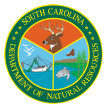 South Carolina Department of Natural Resources (DNR)
South Carolina Department of Natural Resources (DNR) U.S. Fish and Wildlife Service
U.S. Fish and Wildlife Service National Oceanic and Atmospheric Administration (NOAA) National Marine Fisheries Service
National Oceanic and Atmospheric Administration (NOAA) National Marine Fisheries Service Charleston County Parks and Recreation Commission
Charleston County Parks and Recreation Commission